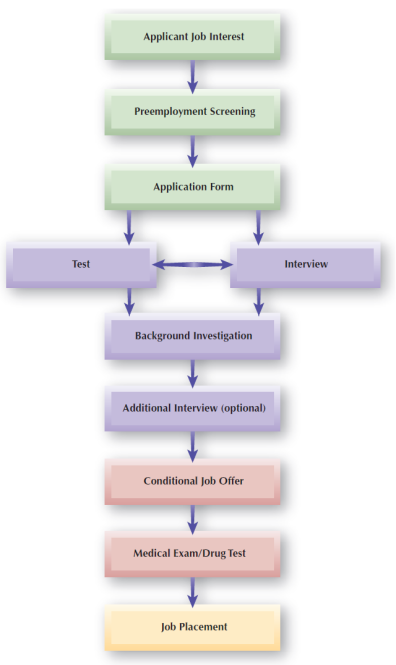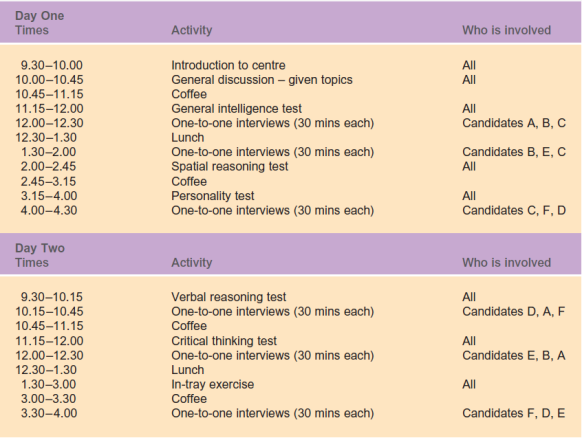Most organizations today, employ a series of consistent steps to process and select applicants for jobs. Figure 1 illustrates a flow chart of such a basic process of selection.
Figure 1: Basic Selection PROCESS
Source: Mathis & Jackson, 2010
“Company size, job characteristics, the number of people needed, the use of electronic technology, and other factors cause variations on the basic process” (Mathis & Jackson, 2010). Traditionally, most organizations relied on the classic trio of steps for selecting candidates, namely, application forms, interviews and references (Armstrong, 2012). However, it is argued that, this classic trio should be complemented by incorporating selection tests and assessment centres (Armstrong, 2012). In addition, research has also highlighted the applicability of techniques such as self-assessment, group selection and work sampling for enhancing the selection process to suit the unique requirements of modern organizations (Torrington, Hall, & Taylor, 2005).
Application Forms
Traditionally, the application form was used as a personal details form, which was intended to act as the nucleus of the personal record of an individual when he/she began work. Today, many organizations have adopted the application form to act as a useful preliminary to employment interviews and decisions, either to present more information that was relevant to such deliberations, or to arrange such information in a standard way (Torrington, Hall, & Taylor, 2005). Preparing the application form to be used as an information source to assist the selection process can be a challenging task to the HR department, yet, a properly prepared application form can serve a modern organization in many different aspects (Mathis & Jackson, 2010; Torrington, Hall, & Taylor, 2005),
- It is a record of the applicant’s desire to obtain a position.
- It organizes all applicants details according to a single standard which expedite sorting of applications and shortlisting of candidates.
- It provides the interviewer with a profile of the applicant that can be used during the interview.
- It is a basic employee record for applicants who are hired.
- It can be used for research on the effectiveness of the selection process.
While there is still a heavy use of CVs for managerial and professional posts in private sector, many organizations, especially in the public sector, is increasingly adopting the application form as a productive alternative to CVs. Some private sector organizations also adopt a hybrid approach in which the application form is used to shortlist the candidates while the CV is used to assist the interviewers along the selection process. Figure 2 illustrates a sample application form.
Figure 2: Sample Application Form
Source: Mathis & Jackson, 2010
Interviews
Arguably the most well-known and the most common step in many selection processes, is the interview. Although “interview” is such a general term in employee selection, it is interesting to note that there are many different variants of interviews. Interviews can be broadly categorized in to structured interviews and unstructured interviews (Armstrong, 2012).
“A structured interview is one based on a defined framework” (Armstrong, 2012). All candidates who have applied for the same job position framed by a given framework are asked the same set of questions and the framework may define a rating system for the candidates by assigning a score to the answer of each question. Structured interviews can be categorized in to different forms (Mathis & Jackson, 2010) and some organizations come up with hybrids of two or more of these forms to suit their own unique selection requirements.
- Biographical Interview: This form of structured interviews focus on a sequential assessment of the candidate’s past experiences in order to provide a sketch of what the candidate has done up to now in his career.
- Behavioural Interview: In this form, candidates are asked to describe how they have performed a certain task or handled a problem in the past. This can provide useful information for the interviewer to predict how the candidate would take decisions and act if he/she were to be selected for the job position. A study (Krajewski, Goffin, McCarthy, Rothstein, & Johnston, 2006) has shown that, behavioural interviews are better at identifying achievement at work than situational interviews, since they focus on what applicants have actually done in real situations opposed to what they think they might do in hypothetical situations.
- Competency Interview: In competency interviews, the interviewer is provided a competency profile, which includes a list of competencies necessary to do that particular job. These competency profiles are useful to interviewers in that, the interviewer can structure his/her questions to the candidate more focused towards the competencies listed in the competency profile. However, it has been argued that the interviewer must be trained in spotting strong answers for the competencies in the candidates (Gurchiek, 2008).
- Situational Interview: Opposed to behavioural interviews, situational interviews assess what the candidate would consider to be the best option, not necessarily what he/she did in a similar situation. In fact, the candidate may not have experienced the same or a similar situation before in his/her career. A variant of this form is known as case study interview, where the candidate is asked how he/she would diagnose and correct a challenge that the organization is currently facing (Mathis & Jackson, 2010).
“An unstructured interview occurs when the interviewer improvises by asking questions that are not predetermined” (Mathis & Jackson, 2010). The general focus behind an unstructured interview is to get an overall picture of the candidate as an individual (Armstrong, 2012).
A variant that lie in-between structured and unstructured interviews is referred to as semi-structured interviews (Mathis & Jackson, 2010). In these semi-structured interviews, a guided conversation is gradually built up between the interviewer and the candidate. The interviewer raises some broad questions to the candidate and new questions arise as a result of the discussion. Some organizations today, especially in the ICT industry, tend to conduct such a semi-structured interview in the form of a telephone interview before calling in the candidate for the structured interview.
Modern organizations, depending on the job requirement, may also exercise another form of interviews known as stress interviews which can be either structured or unstructured (Mathis & Jackson, 2010). In a stress interview, the interviewer assumes an extremely aggressive and insulting posture. However, the rationale behind such an interview is that the particular job position the candidate has applied to involves high degrees of job stress. A good example for such a job position is the customer care and call centre operators.
referrals
In most selection processes, and typically in organizations still following a more traditional process of selecting candidates, contacting referees the candidate has provided is the last step in deciding whether or not the candidate should be offered the employment. “The main purpose of a reference is to obtain in confidence factual information about a prospective employee” (Armstrong, 2012). However, some researchers argue against the use of references as a criterion for selecting candidates on the basis that, no candidate will knowingly pick a reference who would speak poorly of them (Lublin, 2009).
In contrary, some modern organizations make it mandatory for a candidate to provide at least one reference from his/her previous employment, possibly a manager to whom the candidate was reporting to. However, as highlighted in multiple texts (Armstrong, 2012; Mathis & Jackson, 2010) the questions asked from such a referee should be within strict ethical boundaries.
Selection Tests
Selection tests provide an organization a more practical and reliable tool to assess a candidate in various aspects such as levels of abilities, intelligence, personality, aptitudes and attainments (Armstrong, 2012). However, as research has shown, selection tests must be evaluated extensively and test items should be linked to a thorough job analysis, before being utilized as a selection tool (Mathis & Jackson, 2010).
Many different tests that can be used in various selection criteria have been proposed, for example, intelligence tests, ability tests, personality tests, aptitude tests (Armstrong, 2012), honesty/integrity tests (Mathis & Jackson, 2010), trainability tests and attainment tests (Torrington, Hall, & Taylor, 2005).
Assessment Centres
“Assessment centres assemble a group of candidates and use a range of assessment techniques over a concentrated period (one or two days) with the aim of providing a more comprehensive and balanced view of the suitability of individual members of the group” (Armstrong, 2012). Figure 3 illustrates an example of an assessment centre.
Figure 3: An example assessment centre
Source: Torrington, Hall, & Taylor, 2005
A main disadvantage of assessment centres is that, assessment centres require a lengthy design process to select the appropriate activities so that every competency of the candidates will be measured via more than one task. However, research has also proven that assessment centres are one of the most effective ways of selecting candidates (Torrington, Hall, & Taylor, 2005).
Other Forms of Selection Criteria
Self-assessment (Torrington, Hall, & Taylor, 2005) is a technique where the typical selection process is reversed. In this technique, the candidate him/herself evaluates whether he/she is fit to do the job. This can be in the form of a video showing how the actual job looks like, an informal discussion with the current job holders, a self-selection questionnaire on the company website or further information sent with the application form. However, a survey result has shown that only a minority of the modern organizations actually implement this form of selection (Editors of Chartered Institute of Personnel and Development, 2003).
Group selection is arguably the earliest form of assessment centres which has its roots dating back to the Second World War (Torrington, Hall, & Taylor, 2005). There are three main group selection techniques, namely, leaderless groups, command or executive exercises and group problem solving (Plumbley, 1985). Although considered as an older selection technique, modified variants of group selection can still be a cost effective alternative to assessment centres.
Work sampling is the selection technique where a potential candidate for a permanent job will be assessed in a temporary post or a training period within the same organization (Torrington, Hall, & Taylor, 2005). A typical example for work sampling from the modern ICT industry is the internship programs offered by software companies. A close variant of work sampling is the sample work portfolio in which the candidate is expected to present a portfolio of his/her former work at the interview. This technique of selection is common in jobs such as photographers, artists or even UI engineers in the ICT industry.
References
Armstrong, M. (2012). Armstrong’s Handbook of Human Resource Management Practice, 12e, London: Kogan Page.
Chartered Institute of Personnel and Development. (2003). Recruitment and Retention Survey Report 2003. Retrieved from http://www.cipd.co.uk/NR/rdonlyres/B779ADD8-E9EA-4849-BA4E-BAC6E70F24F9/0/recruitretnsurvey.
Gurchiek, K. (2008, January 28). Behavioural Interviewing Popular, but Training in Use Urged. Retrieved from http://www.shrm.org/publications/hrnews/pages/behavioralinterviewingpopular.aspx.
Lublin, J. (2009, April 7). Bulletproofing Your References in the Hunt for a New Job. Retrieved from http://online.wsj.com/news/articles/SB123904785521794145.
Mathis, R. L. & Jackson, J. H. (2010). Human Resource Management, 13e, Mason: South-Western Cengage Learning.
Plumbley, P. R. (1985). Recruitment and Selection, 4e. London: Institute of Personnel Management.
Torrington, D., Hall, L., & Taylor, S. (2005). Human Resource Management, 6e, Essex: Pearson Education Limited.
Krajewski, H. T., Goffin, R. D., McCarthy, J. M., Rothstein, M. G., & Johnston, N. (2006). Comparing the Validity of Structured Interviews for Managerial-Level Employees: Should We Look to the Past or Focus on the Future? Journal of Occupational & Organizational Psychology, 79, 411 – 432.


